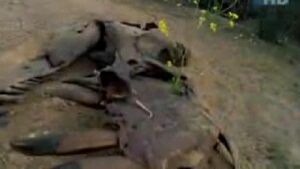(Adding categories) |
|||
| (5 intermediate revisions by 4 users not shown) | |||
| Line 1: | Line 1: | ||
| − | + | [[File:Purgatorius_on_Rex_bones.jpg|thumb|left|300px]]'''''Purgatorius'''''<span style="color:rgb(37,37,37);font-family:sans-serif;line-height:22.399999618530273px;"> is the </span>genus<span style="color:rgb(37,37,37);font-family:sans-serif;line-height:22.399999618530273px;"> of the four </span>extinct<span style="color:rgb(37,37,37);font-family:sans-serif;line-height:22.399999618530273px;"> </span>species<span style="color:rgb(37,37,37);font-family:sans-serif;line-height:22.399999618530273px;"> believed to be the earliest example of a </span>primate<span style="color:rgb(37,37,37);font-family:sans-serif;line-height:22.399999618530273px;"> or a proto-primate, a primatomorph precursor to the </span>Plesiadapiformes<span style="color:rgb(37,37,37);font-family:sans-serif;line-height:22.399999618530273px;">, dating to as old as 65 million years ago. </span><span style="color:rgb(37,37,37);font-family:sans-serif;line-height:22.399999618530273px;">Remains were originally discovered in what is now eastern </span>Montana<span style="color:rgb(37,37,37);font-family:sans-serif;line-height:22.399999618530273px;">'s (United-States), </span>Hell Creek Formation<span style="color:rgb(37,37,37);font-family:sans-serif;line-height:22.399999618530273px;">) and Tullock Formation (early Paleocene, Puercan), specifically at Purgatory Hill (hence the animal's name) in deposits believed to be about 63 million years old. </span><span style="color:rgb(37,37,37);font-family:sans-serif;line-height:22.399999618530273px;">It is thought to have been </span>rat<span style="color:rgb(37,37,37);font-family:sans-serif;line-height:22.399999618530273px;">-sized at 6 in (15 cm) long and 1.3 ounces (about 37g) and a diurnal insectivore, who burrowed through small holes in the ground.</span> |
|
| − | ==[[When Dinosaurs Roamed America]]== |
+ | ==In [[When Dinosaurs Roamed America]]== |
| ⚫ | We only see it in one scene in the early Paleogene segment<span style="font-family:arial,sans-serif;">. </span>After the extinction of the dinosaurs,<span style="font-family:arial,sans-serif;"> a mom and her babies crawl on a </span>''[[Tyrannosaurus rex|T. rex]]'' <span style="font-family:arial,sans-serif;">skull. They were live-acted by opposums. </span <span style="font-family:arial,sans-serif;"> </span> |
||
| − | |||
| + | [[Category:Creatures]] |
||
| ⚫ | |||
| + | [[Category:Cretaceous animals]] |
||
| + | [[Category:Animals]] |
||
| + | [[Category:When Dinosaurs Roamed America animals]] |
||
Revision as of 17:04, 26 July 2018

Purgatorius is the genus of the four extinct species believed to be the earliest example of a primate or a proto-primate, a primatomorph precursor to the Plesiadapiformes, dating to as old as 65 million years ago. Remains were originally discovered in what is now eastern Montana's (United-States), Hell Creek Formation) and Tullock Formation (early Paleocene, Puercan), specifically at Purgatory Hill (hence the animal's name) in deposits believed to be about 63 million years old. It is thought to have been rat-sized at 6 in (15 cm) long and 1.3 ounces (about 37g) and a diurnal insectivore, who burrowed through small holes in the ground.
In When Dinosaurs Roamed America
We only see it in one scene in the early Paleogene segment. After the extinction of the dinosaurs, a mom and her babies crawl on a T. rex skull. They were live-acted by opposums. </span
